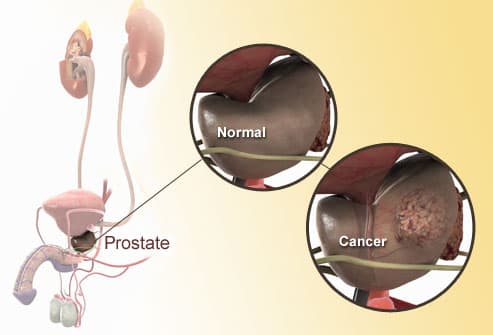Cancer of the prostate is a condition affecting the prostate gland. It is the most common form of cancer in males after skin cancer, affecting one out of nine men. The location of the prostate gland is below the bladder and in front of the rectum. It secretes seminal fluid to aid in sperm transport. Semen is secreted by the seminal vesicles located just behind the prostate gland. It is carried through the urethra, which runs through the prostate gland.
Prostate cancer develops slowly and may be localized, causing no serious harm. Slow-growing cancer requires minimal treatment. But some cases of aggressive prostate cancer require elaborate treatment. Most cases of successful prostate cancer treatment pertain to early detection of cancer.
Incidence and Mortality
In the United States, about 248,530 men received a prostate cancer diagnosis in 2021. The incidence of prostate cancer has shown specific trends since the 1980s. Increased PSA screening resulted in a rise in the incidence rates in the late 1980s and early 1990s. During 2013-2017, the incidence rate has been steady. The average age of men diagnosed with prostate cancer is 66 years and about 60% of the cases are 65 years or older. Men younger than 40 years are less susceptible to it. The incidence rate in blacks is 80% higher than in white men.
In the United States, prostate cancer, the second leading cause of mortality, accounts for 34,130 deaths in the present year. But, this rate of mortality is half as much as during the mid-1990s to mid-2010s due to advances in screening and treatment. The death rate has been steady during the period 2014-2018.
Symptoms and Types of Prostate Cancer
Patients may not show any particular symptoms during the early stages of prostate cancer. Early prostate abnormalities may show up as less urine flow, urgent need to pass urine, or burning sensation when passing urine. Patients may also feel the urge many times throughout the night. Doctors must be informed of these symptoms to find out if they are caused by cancer or some other condition.
Pain in the bones, blood in the urine and semen, trouble with urination and decreased force of the urine stream, erectile dysfunction, and significant weight loss indicate advanced forms of cancer.
Prostate cancer is generally malignant, also referred to as adenocarcinoma. Adenocarcinomas initiate in cells of glands of the prostate. Other cancers affecting the prostate include transitional cell carcinomas, sarcomas, neuroendocrine tumors, and small cell carcinomas.

Causes and Risk Factors of Prostate Cancer
Causes
The cause of prostate cancer is unclear. Changes to the DNA of prostate cells mark the beginning of prostate cancer. This causes cells to grow and divide abnormally. These cells may grow into a tumor and spread to other parts of the body, a process known as metastasizing.
Sometimes, other conditions can also cause symptoms similar to prostate cancer. These include prostatitis, which causes inflammation of the prostate gland. This condition is generally caused due to bacterial invasion and is easily resolved with pharmacological interventions. Another type of prostate enlargement is benign prostatic hyperplasia (BPH). Although BPH does not lead to an increased risk of cancer, it may lead to constriction of the urethra and may resolve with medication or surgery in some cases.
Risk Factors
Prostate cancer has several risk factors including age greater than fifty years, a family history of the cancer variant, diet, and obesity. Having a family history of prostate cancer more than doubles the risk of developing it.
Further, mutated BRCA1 and BRCA2 genes put individuals at a greater risk of developing prostate cancer. These genes are also responsible for ovarian and breast cancers in women. Another genetic condition, Lynch syndrome or hereditary non-polyposis colorectal cancer (HNPCC) also increases prostate cancer risk. Other genes that may raise its risk include HPC1, HPC2, CAPB, FANCA, HOXB13, ATM, and HPCX. But research evidence is limited in this regard.
Black individuals are also susceptible to getting prostate cancer. Hispanic or Latino men and men of Asian-American origin are less likely to get prostate cancer compared to non-Hispanics. Most cases of prostate cancer have occurred in northwestern Europe, North America, Caribbean Islands, and Australia. Fewer cases of prostate cancer are detected in South America, Asia, Central America, and Australia.
Complications
The major risk faced by prostate cancer survivors is the recurrence of cancer. In many cases, patients develop second cancer. Individuals diagnosed and treated for prostate cancer may get cancer of the thyroid, thymus, bladder, small intestine, soft tissue, and melanoma of the skin. Radiation therapy may put a person at a greater risk of acute myeloid leukemia (AML) or rectal cancer. Regular follow-ups with the oncologist are essential after prostate cancer treatment. Further, maintaining a healthy weight with the required exercise, and avoiding alcohol, sugar, and processed foods and meats helps maintain good health following recovery from prostate cancer.
Prostate cancer and its treatment can lead to several complications such as urinary incontinence and erectile dysfunction. The most probable complication of prostate cancer is metastasizing or spread to nearby organs such as the bladder. It may also affect the lymphatic or skeletal systems. Urinary incontinence is treated based on its severity using catheters, medications, or surgery. Treatment involving hormones, radiation, or surgery can also lead to erectile dysfunction. Erectile dysfunction is often treated using medication and vacuum devices.
Stages of Prostate Cancer
The stages of prostate cancer are determined using Grade Groups and a Gleason Score. These methods assess the projected aggressiveness of prostate cancer. Cells in the sample are assigned a score from three to five, with three representing a slow-growing form of cancer and five an aggressive form. Two common grades are used to give a Gleason score. This score is used to assign a group from one to five. Group 1 refers to slow-growing cancer while Grade 5 refers to an aggressive form of cancer.
Prostate Cancer Diagnosis and Treatment
The conventional methods of prostate cancer diagnosis are digital rectal exams, prostate biopsy, and prostate-specific antigen (PSA) tests. In a digital rectal exam, the care provider performs a physical examination of the rectum and identifies bumps or possible abnormalities in the prostate gland indicating cancer. The PSA test detects elevated levels of the prostate-specific antigen which indicates cancer. However, PSA levels are also elevated in the case of prostatitis or BPH, and your provider will rule out the possibility of the occurrence of these conditions. Another method to detect prostate cancer is through a needle biopsy of the sample, possibly containing cancer cells. An MRI-guided biopsy is a standard for detecting prostate cancer, which provides detailed images relating to the prostate during the examination.
The strategies for managing prostate cancer are watchful waiting, radiation, cryotherapy, and surgery. Watchful waiting is a preferred choice in many cases as prostate cancer grows at a slow pace and is localized. Watchful waiting involves monitoring the system. The treatment is not administered in this protocol. However, regular biopsies are undertaken to get a fair idea of cancer progression. Men who do not prefer cancer therapy or cannot opt for it are good candidates for watchful waiting. Watchful waiting helps when a patient has a condition that could interfere with an aggressive form of treatment. The procedure is affordable and does not have any risks, side effects, or complications. However, there are chances of the cancer spreading which may become difficult to manage over time.
Radiation therapy uses high-energy rays to target cancer cells. It is used as the primary mode of treatment, but may also follow surgery in the case of recurrence if it is not fully removed. Radiation is administered as photon beams (low radiation that may scatter to nearby healthy tissue) or protein beams (contain heavy mass and target deep tissue). Another form of radiation is prostate brachytherapy which is a form of internal radiation. In this therapy, a hollow needle is used to place a radioactive substance in the prostate. It may be either low dose rate (LDR) brachytherapy or high dose rate (HDR) brachytherapy. When cancer has metastasized, chemotherapy is administered as circulating drugs in the bloodstream to destroy the cancer cells. They are given intravenously and carefully controlled as they destroy both healthy and cancerous cells.
Another form of treatment for prostate cancer is cryotherapy. This involves the freezing of the prostate gland in a controlled manner to destroy the cells. Anesthesia is given to the patient before undertaking the procedure and cryoprobes, a type of needle is placed in the prostate under the skin. Ultrasound is used for the freezing process. A catheter is placed to help the patient urinate and regular monitoring and PSA tests are used to determine the status of cancer. Cryotherapy is recommended for patients who cannot undertake radiation. However, it comes with side effects such as the development of fistula after surgery, incontinence, and erectile dysfunction.
When a fast-growing cancer is detected, the modes of treatment are internal radiation or brachytherapy, prostatectomy surgery, or focal therapy. Radical prostatectomy is a surgery undertaken for the removal of the prostate when cancer has reached advanced stages. The three types of radical prostatectomy surgeries are Robotic Assisted Laparoscopic Prostatectomy (RALP) involving a robotic system, laparoscope, and camera to navigate and remove the prostate, Retropubic Open Radical Prostatectomy involving the removal of the prostate through an incision in the lower belly, and Laparoscopic Radical Prostatectomy involving removal of the prostate through small cuts in the abdomen. Prostatectomy is generally followed by a reconstruction of the bladder and urinary tract and placing a catheter for drainage of urine.
Disclaimer:
“KareOptions does not have any intention to provide specific medical advice, but rather to provide its users and/ or the general public with information to better understand their health. All content (including text, graphics, images, information, etc.) provided herein is for general informational purposes only and is not a substitute for professional medical advice, care, diagnosis, or treatment. KareOptions makes no representation and assumes no responsibility/ liability for the accuracy of the information, advice, diagnosis, treatment provided herein or on its website. NEVER DISREGARD PROFESSIONAL MEDICAL ADVICE OR DELAY IN SEEKING TREATMENT BECAUSE OF SOMETHING YOU HAVE READ IT HERE OR ACCESSED THROUGH THE KAREOPTIONS WEBSITE.


